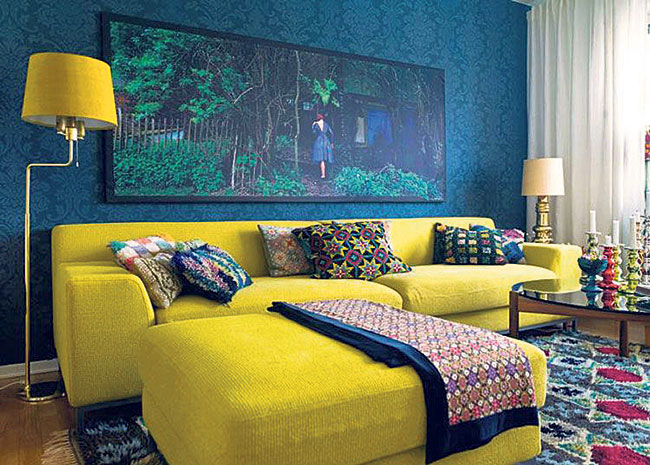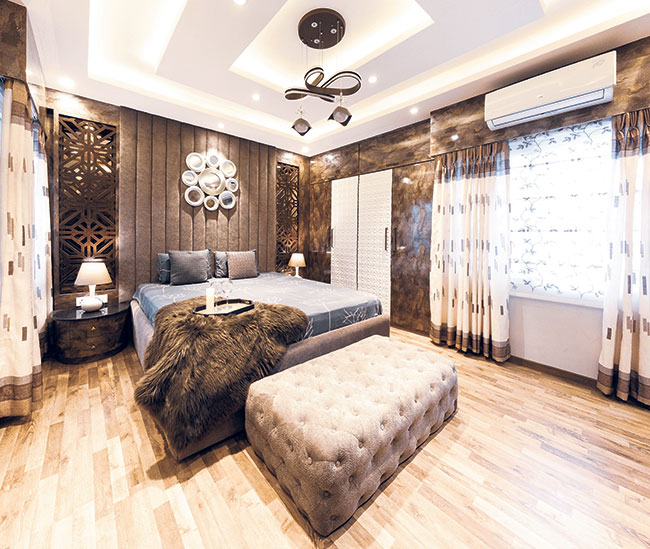If you are one of those “Architectural Digest” fanatics binging through each and every celebrity home tour, then you are probably already familiar with luxury living—at least on the screen. These celebrity houses are filled with centuries-old artifacts and paintings and consist of furniture only the French can pronounce. But, most importantly, they show us just how creative and unique living spaces can be. But can we, non-celebrity folks, make a “Xanadu” of our own fitted with all sorts of luxurious items one can imagine? Sandipa Tamang, founder of Decor Debute, an interior designing firm, answers in the affirmative.
Tamang started Decor Debute (also known as Interior Design Nepal) around two years ago and the firm is based Sanepa Heights in Lalitpur. Here, Tamang and her team tell us all about the art of luxury when it comes to decor and interior design.
Major things to consider in luxury decor

The walls define the living space
According to Tamang, walls can make or break a living space. Be it the color, the texture or generally how the walls look can tell you know if the home you’ve entered is a luxurious one or not.
“Usually, walls that are treated with glass and stones are considered posh. Moreover, paneling of the wall with wood or ply can give the walls that extra touch of grandness,” she says. According to Tamang, the kind and color of paint one uses also determines the aesthetics of a home. The cladding of the walls with stones or using texture paint is also one way to add a luxurious dimension to the walls.
Furniture placement is key
“For the longest time, classical furniture has been synonymous with luxury. But as of now, though classical furniture has its space in the luxury hierarchy, minimalistic and chic designs can be made equally lavish,” reveals Tamang. As the name clearly suggests, classical furniture has a long history. In the past, homes used to be big, so they were able to accommodate large pieces of furniture.
While I may be the first woman in this office, I will not be th...

Similarly, classical furniture is heavily detailed and has a lot of patterns and textures on it. These, in the past (and even now), used to be expensive and thus defined luxury. “So if you want your home to have a luxurious feel, classical furniture is the easy way to go,” adds Tamang.
Nowadays, however, minimalistic and simple furniture designs can also look equally good. As the sizes of our living spaces have shrunk in comparison to the past, people have begun to opt for simple yet chic designs. “Minimalistic furniture is usually well defined and contains a sharp finish which is attractive to most people who want luxury in 2020,” says Tamang.
Indoor plants are a must
In all of the celebrity homes you get to see in the Architectural Digest, you will notice they all have one thing in common—plants. Having a little green is a must if you want to give your home that lavish feel. Even historically, houseplants were for the rich. In Chinese houses, the Chinese money tree was (and is still) seen as a sign of wealth. Moreover, for many years, the art of bonsai making was practiced only by the wealthy Japanese and it came to be known as a nobleman’s privilege and thus the bonsai trees became a symbol of prestige and honor. This just goes on to show that indoor plants have always been considered important in luxury living.
“Hanging plants or plants that crawl up the wall are especially popular nowadays,” says Tamang. But indoor plants require constant care and take time to reach their full potential and so people have started to opt for fake greens and crawlers, as they give a home that necessary shade of green but don’t require any attention thereafter.
Owning and displaying art is luxury
According to an article in The Orchard Times, for many estate agents, art has become the new key to selling luxurious homes. The article states that luxury properties are now invariably furnished with vast canvases, glass cases housing exquisite antiques, bespoke carpets, sofas, lights, and sculptures. Owning any form of art is said to add that lavish touch to a home.
“In the case of Nepal, art is where most people seem to be lacking when it comes to luxurious decor,” she says, adding that, however, sourcing artists and commissioning them to make wall art, graffiti, 3-D designs are slowly becoming the new décor mantra for many.
Most of the time, abstract art, independent sculpture piece, framed paintings are mostly found in luxurious homes. “As art is very subjective, it highly depends on the individual what form of art they want to display,” says Tamang.

Products and designs that define luxury
Tamang reveals that one doesn’t have to start from scratch to give their home a luxurious feel. By adding or subtracting things one can make their home look lavish. Here are a few designing tips as well as a few product recommendations to glam up your living space.
Add a divan or two
A divan is a piece of couch-like seating furniture or, in some countries, a box-spring based bed. In this case, we’re talking about the couch-like seating furniture. The divan has its origins in the Middle East. It was considered fashionable, roughly from 1820 to 1850, in places where the romantic movements in literature came from. Divan, especially those made with velvet dyed with royal colors like purple, maroon and ivory, can make your living room extremely stylish and pricey to boot.
The charm of a king-size bed
The name says it all. Historians believe that the first king-sized bed was created in 1890, and was far larger than the modern day king-size bed as it could fit up to 15 people. Large beds with extra layers of cotton and wool define comfort and luxury. “Along with supreme comfort, a king-size will also give you that feel of grandness in your bedroom,” adds Tamang.
Ottoman and Bergère chairs for the classy feel
A Bergère chair is a type of upholstered armchair that originated in the 18th century and was the first type of chair to focus on comfort and relaxation. Similarly, the ottoman (a padded, low-lying upholstered chair) gets in name from the Ottoman Empire of the 1700s. “Both of these furniture were and are still considered to be lavish,” says Tamang. Moreover, the ottoman and bergère chairs have also gotten modern makeovers and can fit extremely well in a minimalistic/chic home as well.
Chandeliers for the win
Unlike simple decor, luxury decor puts equal parts focus on layered decorative lighting and chandeliers are an important part of it. Traditionally, chandeliers used to be grand, flashy and no doubt, expensive. Surprisingly, chandeliers like this still have their audience. However, in the contemporary style, chandeliers have been modified into more compact and chic structures that add a subtle grandeur to a home. “Most chandeliers that we’ve designed for our clients have a more subtle and retro feel to them,” says Tamang.

Luxury and sustainability
It’s no secret that luxury is expensive. Most of the time, luxury items tend to be customized and thus use extra energy and the best of raw materials. And considering the sustainability and eco-friendly movement that’s spreading across the world, the question of sustainability in luxury decor comes into play as well.
“I wouldn’t say luxury decor and sustainability or green living are mutually exclusive but I have to admit that it can be extremely difficult to achieve both,” reveals Tamang.
In the past, people took pride in owning the most exotic velvet divan or having built a heavily detailed wood cabinet, but today, people (no matter how rich) don’t have the liberty to do so without straining the world’s resources. So, according to Tamang, the only place where these two ideas meet is minimalism.
“There has to be a compromise if someone wants the best of both worlds. But as minimalism is a trend now, by owning quality products (that will last for a long time) but making do with only a few of them, one can live luxuriously without feeling like they are overusing the earth’s resources,” she concludes.





































